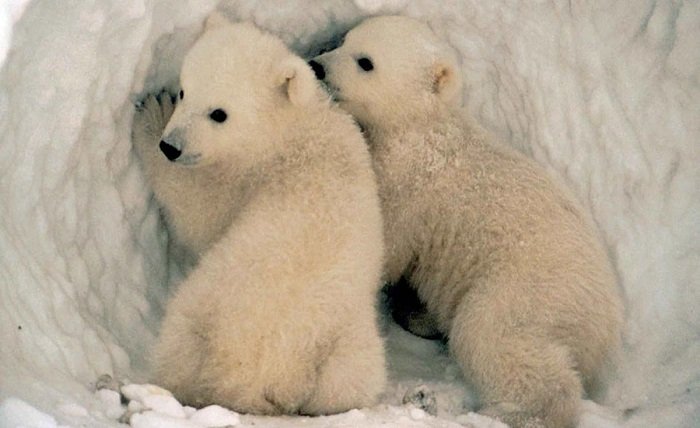The Enchanting World of the Baby Polar Bear: Insights and Discoveries

The Arctic, a realm of icy landscapes and frigid temperatures, is the home to one of the most endearing creatures on the planet—the baby polar bear. Known scientifically as Ursus maritimus, these cubs are born into a world of snow and ice, requiring incredible resilience and care from their mothers to survive in such extreme conditions. This blog post delves into the lives of baby polar bears, exploring their development, behavior, and the challenges they face from the moment of birth.
Birth and Early Days
Baby polar bears are born during the heart of winter, typically in December or January, in the deep seclusion of a snow den. These cubs are incredibly small at birth, weighing just over a pound, and are both blind and deaf. Their initial weeks are spent in the warmth of the den under the vigilant care of their mother. During this critical period, the mother’s body heat and rich milk, which is thick with fat, are essential for the survival of the baby polar bears, shielding them from the Arctic’s harsh realities.
First Steps Outside the Den
As spring approaches, usually around March or April, baby polar bears make their first tentative steps outside the den. This momentous occasion marks a significant milestone in their lives. The world outside offers myriad stimuli: vast snowy expanses, the stark contrast of the Arctic’s blue skies, and the fresh, cold air. These initial exposures are critical as the cubs learn to navigate their environment, albeit clumsily at first.
Learning Through Play
Play is a crucial part of the development of baby polar bears. It not only provides them with physical exercise but also teaches them vital survival skills. Cubs learn to wrestle with their siblings, a playful mimicry of the combat skills they require as adults. These interactions help strengthen their muscles and refine their coordination, preparing them for the challenges of Arctic living.
Maternal Bond and Learning
The bond between a mother polar bear and her cubs is profound and essential for the cubs’ survival. During the first two years of life, baby polar bears rely heavily on their mothers for nourishment and protection. This period is also crucial for learning—mothers teach their cubs how to hunt for seals, navigate the icy terrain, and protect themselves from predators and other threats.
Dietary Needs of Growing Cubs
As baby polar bears grow, their dietary needs evolve. Initially dependent solely on their mother’s milk, they gradually transition to solid food. This shift begins as they learn to hunt seals with their mother, a skill that is critical for their survival in the Arctic’s food-scarce environment. The rich, fatty meat of seals becomes a staple in their diet, vital for building the fat reserves they need to withstand the cold.
Playful Antics and Social Interactions
Baby polar bears are not just about survival; they are also incredibly playful and curious. Their play is not merely a form of entertainment but a way to learn about the world around them. Through their playful antics, they interact with their environment, learning how to manage their physical bodies in the Arctic landscape and understand social cues from their mother and siblings.
Adaptations to the Cold
The physical adaptations of baby polar bears to the cold are remarkable. From their thick, water-repellent fur to their layer of fat that insulates against the freezing temperatures, every aspect of their physiology is designed to conserve heat. Even their small ears and tails help minimize heat loss, ensuring they retain as much warmth as possible during the frigid Arctic months.
The Impact of Climate Change
Climate change poses a significant threat to the habitat of polar bears. As the Arctic ice continues to melt at alarming rates, the natural habitat of polar bears is drastically shrinking, affecting their ability to find food and survive. Baby polar bears are particularly vulnerable as their environment changes faster than they can adapt. This section explores the impacts of global warming on these cubs and the broader implications for the species.
Conservation Efforts
Conservation efforts are critical to the survival of polar bears, and understanding the challenges faced by baby polar bears is crucial to these efforts. Various initiatives aim to protect their dwindling habitat and address the challenges posed by climate change. This part discusses the role of international treaties, wildlife organizations, and individual actions in safeguarding the future of polar bears.
The Role of Zoos and Research
In addition to wild conservation efforts, zoos and research institutions play a pivotal role in studying and protecting polar bears. Programs that simulate Arctic conditions help researchers understand more about polar bear biology and behavior, including the developmental stages of baby polar bears. This research is invaluable for conservation strategies and educational outreach.
Polar Bears in Indigenous Cultures
Polar bears hold a significant place in the culture and spirituality of Indigenous peoples of the Arctic. This section explores how these communities view and interact with polar bears, including the sacred and practical aspects of this relationship. Understanding these perspectives is important for inclusive and effective conservation efforts that respect both the wildlife and the human cultures of the Arctic.
Conclusion
Baby polar bears represent both the vulnerability and resilience of Arctic wildlife. From their first steps in the snowy expanses to their playful learning and challenging survival, these cubs encapsulate the spirit of the northernmost parts of our planet. Ensuring their survival is not just about protecting a single species but about preserving the ecological balance of the Arctic and, by extension, the health of the planet.
FAQs
Q1: How long do baby polar bears stay with their mother? A1: Baby polar bears typically stay with their mother for about two and a half years before venturing out on their own.
Q2: What do baby polar bears eat? A2: Initially, they feed exclusively on their mother’s milk. As they grow, they gradually start consuming solid food, primarily seals, which they hunt with their mother.
Q3: How do baby polar bears adapt to the cold? A3: They have several adaptations including thick fur, a layer of fat for insulation, and small ears and tails that minimize heat loss.
Q4: What are the main threats to baby polar bears? A4: The primary threats include climate change, which affects their ice habitat and food sources, and human activities such as oil drilling and shipping.
Q5: How can we help protect baby polar bears? A5: Supporting conservation efforts, reducing carbon footprints, and spreading awareness about the impact of climate change on Arctic wildlife are key ways to help protect baby polar bears and their habitat.





